Did you know that Italian green beans, also known as Fagiolini in Umido, are a beloved side dish in Italy? Their popularity extends beyond their home country, captivating taste buds worldwide. These tender, vibrant beans are not only delicious but also a healthy addition to any meal. Join me as we explore the delightful world of Italian green beans and discover fresh recipes that embody the essence of Italian cuisine.
Key Takeaways:
- Italian green beans, or Fagiolini in Umido, are a popular side dish in Italy.
- These beans are not only flavorful but also provide various health benefits.
- Italian green beans can be easily incorporated into a vegetarian or vegan diet.
- Traditional Italian recipes highlight the natural flavors of the beans.
- Italian green beans are a versatile ingredient that can be enjoyed in various dishes.
Italian Green Beans in Tomato Sauce: A Simple and Delectable Side Dish
When it comes to Italian cuisine, simplicity and delicious flavors go hand in hand. One classic Italian side dish that exemplifies this is Italian Green Beans in Tomato Sauce, also known as Fagiolini in Umido. This traditional recipe combines the freshness of green beans with the rich flavors of garlic and cherry tomato sauce, creating a truly satisfying dish.
Italian Green Beans in Tomato Sauce is incredibly easy to make and requires just a few basic ingredients. Begin by blanching the green beans until they are tender yet crisp. Meanwhile, prepare a simple sauce by sautéing garlic in olive oil and adding cherry tomatoes. Allow the tomatoes to simmer and break down, creating a flavorful sauce. Finally, toss the blanched green beans in the tomato sauce, coating them evenly.
The result is a side dish that bursts with a harmonious blend of flavors. The green beans maintain their vibrant color and snap, while the garlic adds a delightful aroma. The cherry tomato sauce adds a touch of sweetness and acidity, perfectly complementing the natural taste of the beans. This dish is versatile and pairs well with a variety of proteins, such as grilled fish, chicken, or meats.
To get a better idea of how to make Italian Green Beans in Tomato Sauce, here is a simple recipe to follow:
Italian Green Beans in Tomato Sauce Recipe:
- 1 pound Italian green beans
- 2 cloves garlic, minced
- 1 pint cherry tomatoes
- 2 tablespoons olive oil
- Salt and pepper to taste
1. Bring a pot of salted water to a boil and blanch the green beans for 3-4 minutes until tender yet crisp. Drain and set aside.
2. In a large skillet, heat olive oil over medium heat. Add minced garlic and sauté until fragrant, about 1-2 minutes.
3. Add cherry tomatoes to the skillet and cook until they begin to soften and release their juices, about 5-7 minutes.
4. Gently mash the cherry tomatoes with a fork or spoon to create a chunky sauce. Season with salt and pepper to taste.
5. Add the blanched green beans to the skillet and toss to coat them evenly in the tomato sauce. Cook for an additional 2-3 minutes until heated through.
6. Serve the Italian Green Beans in Tomato Sauce as a side dish alongside your favorite grilled fish, chicken, or meats.
With just a few simple steps, you can create a delicious and flavorful side dish that perfectly embodies the essence of Italian cuisine. Italian Green Beans in Tomato Sauce adds a touch of freshness and vibrancy to any meal, making it a versatile and delectable addition to your recipe repertoire.
Tips:
- For an extra burst of flavor, consider adding some fresh herbs like basil or parsley to the dish.
- Feel free to customize the recipe by adding additional ingredients such as olives or capers for a Mediterranean twist.
- If you prefer a spicier sauce, sprinkle some red pepper flakes into the tomato sauce.
- This dish can also be enjoyed on its own as a vegetarian main course or added to pasta for a heartier meal.
The Versatility of Italian Green Beans in Mediterranean Cuisine
Italian green beans are a versatile ingredient in Mediterranean cuisine. They can be blanched quickly in boiling water to retain their crispness and bright green color. The beans can be sautéed with olive oil and garlic or tossed with sun-dried tomatoes and pine nuts for a delicious contorno, or side dish. They can also be combined with potatoes and pesto for a traditional Italian twist. Italian green beans add a vibrant and flavorful element to any Mediterranean-inspired meal.
Italian green beans are a staple in Mediterranean cuisine, known for their versatility. They can be prepared in various ways, offering different textures and flavors to complement a wide range of dishes. Whether blanched, sautéed, or used as a key component in a contorno or side dish, Italian green beans bring their vibrant color and fresh taste to the forefront.
Blanching Italian green beans is a quick and easy method to cook them while retaining their crunchy bite. By briefly plunging the beans into boiling water and then transferring them to an ice bath, their bright green color is preserved, making them visually appealing as well. This blanching technique is ideal for serving the beans as a standalone side dish or adding them to salads and pasta dishes.
Sautéing Italian green beans with olive oil and garlic creates a flavorful and aromatic dish that pairs well with a variety of main courses. The combination of the tender yet slightly crisp beans with the rich and savory flavors of olive oil and garlic is a classic Mediterranean combination that never fails to satisfy.
“Italian green beans are one of my favorite ingredients to work with in Mediterranean cuisine. Their versatility allows for endless creativity in the kitchen. Whether I’m preparing a simple side dish or adding them to a complex pasta dish, the green beans always elevate the flavors and bring a fresh element to the plate.”
In addition to being a side dish on their own, Italian green beans can be combined with other ingredients to create a contorno, or side dish, that complements a main course. Tossing the beans with sun-dried tomatoes and pine nuts adds a burst of sweetness and a satisfying crunch to each bite. The combination of flavors creates a dynamic side dish that pairs well with grilled meats or fish.
For a traditional Italian twist, Italian green beans can be cooked with potatoes and pesto. The earthiness of the potatoes combined with the herbal flavors of the pesto brings a distinct Mediterranean taste to the dish. This combination of ingredients is not only delicious but also visually appealing, with the vibrant green of the beans contrasting with the golden hues of the potatoes.
Italian green beans are a versatile and flavorful ingredient that adds a Mediterranean touch to any meal. Whether blanched, sautéed, or used as a side dish, these beans bring a burst of freshness and color to your plate. Get creative in the kitchen and explore the endless possibilities of Italian green beans in Mediterranean cuisine.
Greek Green Beans: A Savory and Refreshing Addition to Traditional Dishes
Green beans are a beloved ingredient in Greek cuisine, adding a savory and refreshing element to traditional dishes. Whether it’s a classic summer dish or a vibrant salad, green beans bring Mediterranean flavors to the table. Let’s explore some delightful Greek recipes featuring these versatile beans.
Fasolakia Lathera
“Fasolakia Lathera is a classic Greek summer dish, where the beans are simmered with ripe tomatoes, onions, and olive oil until tender and infused with Mediterranean flavors.”
Fasolakia Lathera is a simple yet satisfying dish that showcases the natural flavors of green beans. The beans are cooked slowly with ripe tomatoes, onions, and a generous amount of fragrant olive oil. This gentle simmering process allows the beans to absorb all the delicious flavors, resulting in a tender and mouthwatering dish. Fasolakia Lathera is commonly enjoyed as a main course or served as a side alongside crusty bread.
Moussaka
“Green beans are also a vibrant addition to moussaka, contrasting with eggplant and a savory meat sauce.”
Moussaka is a beloved Greek dish that combines layers of eggplant, minced meat, and béchamel sauce. Adding green beans to the mix brings a delightful contrast to the rich and savory flavors. The vibrant green beans provide a pop of freshness and texture, enhancing the overall experience of this classic Greek casserole. Moussaka is typically baked until golden and served as a hearty main course for special occasions or family gatherings.
Greek Green Bean Salad
“In Greek green bean salad, the beans are tossed with fresh dill, red onions, lemon juice, and olive oil for a refreshing and tangy side dish.”
Greek green bean salad is a light and tangy side dish that combines the vibrant flavors of green beans with zesty ingredients. The beans are blanched until tender-crisp and then tossed with fresh dill, red onions, lemon juice, and a drizzle of extra virgin olive oil. This refreshing salad is perfect for hot summer days or as a refreshing accompaniment to grilled meats or seafood. Its tangy and bright flavors make it a popular choice during festive occasions and outdoor gatherings.
Pairing with Peas and Artichokes
Green beans are often paired with peas and artichokes to create a colorful and nourishing combination. These ingredients come together in various Greek dishes, adding depth and complexity to the flavors. Whether it’s a hearty stew or a vibrant vegetable medley, the combination of green beans, peas, and artichokes creates a satisfying and well-balanced dish. The natural sweetness of the peas and the earthy flavors of the artichokes complement the savory notes of the green beans, resulting in a harmonious blend.
| Recipe | Description |
|---|---|
| Fasolakia Lathera | A classic Greek summer dish featuring green beans simmered with tomatoes, onions, and olive oil. |
| Moussaka | A traditional Greek casserole with layers of eggplant, minced meat, and green beans. |
| Greek Green Bean Salad | A refreshing salad of blanched green beans tossed with dill, red onions, lemon juice, and olive oil. |
| Peas and Artichokes | A beautiful combination of green beans, peas, and artichokes in various Greek dishes. |
Pairing Green Beans with Local Ingredients in Southern European Cuisine
When it comes to Southern European cuisine, green beans are often paired with local ingredients to create delightful dishes that showcase the region’s flavors. These vibrant legumes can be transformed into culinary masterpieces by combining them with various elements that enhance their taste and texture. Let’s explore some of the perfect partners for green beans in Southern European cuisine.
Olive Oil: A Golden Drizzle
One of the key ingredients that elevates the flavor of green beans in Southern European cuisine is the golden drizzle of extra virgin olive oil. This luscious oil not only enhances the natural taste of the beans but also adds a touch of richness to the dish. Olive oil is a staple in Mediterranean cooking, and its fruity and herbal notes perfectly complement the freshness of green beans.
Aromatic Herbs: Fragrant Infusions
Aromatic herbs like rosemary, thyme, and oregano play a vital role in infusing green beans with delightful fragrances. These herbs can be added to dishes either dried or fresh to enhance the overall flavor profile. Whether you’re sautéing the beans or simmering them in a sauce, the addition of aromatic herbs brings a delightful earthiness to the dish.
Proteins and Cheeses: Perfect Complements
In Southern European cuisine, green beans are often paired with proteins and cheeses to create a perfect balance of flavors and textures. Seafood, such as shrimp or calamari, can be added to green bean dishes to provide a delicious contrast to their crunchiness. Cured meats like prosciutto also make a delightful addition, adding a savory and salty element. Cheeses such as parmigiano-reggiano and feta can be sprinkled over green beans to create a creamy and tangy note.
Tomatoes: Juicy and Acidic
No Southern European dish is complete without the vibrant flavors of vine-ripened tomatoes. These juicy and acidic fruits provide a refreshing contrast to the freshness of green beans. Whether they’re diced and added to a sauté or roasted and combined with the beans, tomatoes lend a bright and tangy note that complements the dish perfectly.
Incorporating these local ingredients into green bean recipes allows you to savor the essence of Southern European cuisine. The combination of golden olive oil, aromatic herbs, proteins, cheeses, and vine-ripened tomatoes creates a harmonious blend of flavors that truly highlight the best of the region’s gastronomy.
Green Beans in the Mediterranean Diet: Nutritional Benefits
Green beans are a nutritious addition to the Mediterranean diet, known for its health benefits. These vibrant legumes are packed with essential nutrients that support overall well-being.
Fiber: Green beans are an excellent source of fiber, which aids in digestion and promotes a feeling of fullness. A diet high in fiber can help regulate blood sugar levels and promote a healthy weight.
Vitamin C: Rich in vitamin C, green beans boost the immune system and promote healthy skin. This powerful antioxidant helps protect the body against damage caused by free radicals and supports collagen production.
Vitamin K: Green beans contain vitamin K, which is vital for bone health and blood clotting. Adequate vitamin K intake helps maintain strong bones and supports proper blood coagulation.
Folate: These legumes are a good source of folate, which is important for cellular growth, DNA synthesis, and the production of red and white blood cells. Folate is especially crucial during pregnancy for the healthy development of the baby’s neural tube.
Heart-Healthy: Green beans are low in fat and cholesterol, making them heart-healthy. Including green beans in your diet can help maintain healthy cholesterol levels and reduce the risk of heart disease.
Potassium: The potassium content in green beans helps regulate blood pressure, maintaining a healthy cardiovascular system. Potassium is essential for proper muscle and nerve function as well.
To further emphasize the nutritional benefits of green beans, here is a table summarizing their key nutrients:
| Nutrient | Amount per 1 cup (125g) of cooked green beans |
|---|---|
| Fiber | 4 grams |
| Vitamin C | 12 milligrams |
| Vitamin K | 20 micrograms |
| Folate | 42 micrograms |
| Potassium | 225 milligrams |
Green beans are a delicious and nutritious choice for anyone following the Mediterranean diet or looking to incorporate more plant-based foods into their meals. Their versatility makes them easy to incorporate into a variety of dishes, providing a flavorful and healthful addition to your diet.
Celebrating the Versatility of Green Beans in Italian and Greek Cuisine
Green beans are a versatile ingredient in both Italian and Greek cuisine. In Italian cuisine, they are featured in traditional dishes such as contorni (side dishes) and soups like minestrone. Italian green beans are often paired with seasonal ingredients like tomatoes, potatoes, garlic, and aromatic herbs such as oregano. These flavorful combinations create delicious and authentic Italian dishes that showcase the versatility of green beans.
In Greek cuisine, green beans take center stage in dishes like fasolakia lathera and moussaka. Fasolakia lathera is a comforting dish where green beans are combined with seasonal ingredients like tomatoes, garlic, and dill, creating a harmonious blend of flavors. Moussaka, a famous Greek casserole, features layers of eggplant, meat sauce, and green beans, showcasing the versatility of this versatile ingredient.
Whether it’s the vibrant colors, bold flavors, or nutritional benefits, green beans add depth and excitement to both Italian and Greek cuisine. With their ability to accentuate the flavors of other ingredients, green beans provide a fresh and wholesome addition to traditional dishes, making them a favorite among cooks and food enthusiasts.
| Italian Cuisine | Greek Cuisine |
|---|---|
| Contorni (side dishes) | Fasolakia lathera |
| Minestrone soup | Moussaka |
| Tomatoes | Tomatoes |
| Potatoes | Potatoes |
| Garlic | Garlic |
| Oregano | Lemon |
Green beans effortlessly showcase their adaptability as they blend harmoniously with the flavors of both Italian and Greek cuisine. Whether it’s the summer freshness of Italian contorni or the rich and flavorful Greek delicacies, green beans are a versatile ingredient that adds depth and excitement to these traditional dishes.
Tips for Cooking with Green Beans and Storing Leftovers
Cooking with green beans is a delightful culinary experience that allows you to explore various flavor profiles and cooking techniques. Whether you prefer the crispness of blanched green beans or the savory flavors of sautéed ones, there are endless possibilities to elevate your dishes. Here are a few tips and tricks to make the most of your green bean cooking adventures:
Blanching Green Beans for Optimal Texture
To retain the vibrant green color and crispness of green beans, blanching is the way to go. Start by bringing a pot of salted water to a boil, then add the green beans and cook them for 2-3 minutes. Once they are tender-crisp, transfer them to an ice water bath to stop the cooking process. This blanching technique ensures that your green beans maintain their beautiful color and retain a satisfying crunch.
Sautéing Green Beans for Flavorful Variations
If you’re looking to add a burst of flavor to your green beans, sautéing them with garlic and olive oil is an excellent choice. Heat some olive oil in a skillet, add minced garlic, and cook it until fragrant. Then, toss in the green beans and sauté them until they are tender yet still retain some bite. This cooking method infuses the green beans with delightful flavors and makes them a perfect side dish for any meal.
Experimenting with Flavor Variations
While green beans are delicious on their own, you can take their taste to the next level by incorporating various flavor variations. Try adding herbs like thyme, rosemary, or oregano to enhance the earthiness of the beans. For a tangy twist, squeeze a bit of lemon juice over the sautéed green beans. Explore different combinations of spices, herbs, and seasonings to create unique flavor profiles that suit your palate.
Using Canned Green Beans in a Pinch
When fresh green beans are not readily available, you can always turn to canned green beans for a convenient alternative. While they may have a slightly softer texture compared to fresh green beans, they can still be used in various dishes. Canned green beans are particularly suitable for recipes that involve sauces or longer cooking times, as they readily absorb flavors and become tender. Simply drain and rinse the canned green beans before incorporating them into your favorite recipes.
Storing Leftover Green Beans for Future Meals
If you find yourself with leftover green beans, don’t let them go to waste! Green beans can be stored in an airtight container in the refrigerator for up to 3-4 days. To store them for a longer period, consider freezing them. Blanch the green beans before freezing to maintain their texture and flavor. Spread them in a single layer on a baking sheet and freeze until firm, then transfer them to a freezer-safe bag or container. Frozen green beans can be stored for up to 2 months and easily thawed when you’re ready to use them.
With these cooking tips and storage techniques, you can confidently explore the world of green beans and create delicious dishes that showcase their flavor and versatility.
“Cooking with green beans allows you to play with flavors and textures, creating both comforting and vibrant dishes.” – Chef Maria Rossi
Conclusion
Italian green beans and Greek green beans are versatile ingredients that play a significant role in traditional Italian and Greek cuisine. Their fresh and vibrant flavor enhances a variety of dishes, making them a staple in Mediterranean cooking.
Not only do green beans add a burst of color to your plate, but they also pack a nutritional punch. These beans are rich in fiber, vitamin C, and vitamin K, making them a healthy choice for those following the Mediterranean diet.
Cooking with green beans is easy and offers a range of possibilities. Whether you blanch them to retain their crunch or sauté them with olive oil and garlic for added flavor, green beans can be adapted to suit various tastes and preferences.
By incorporating green beans into your cooking and exploring the culinary delights of Italian and Greek cuisine, you can enjoy the essence of Southern European gastronomy while reaping the nutritional benefits of this versatile ingredient.

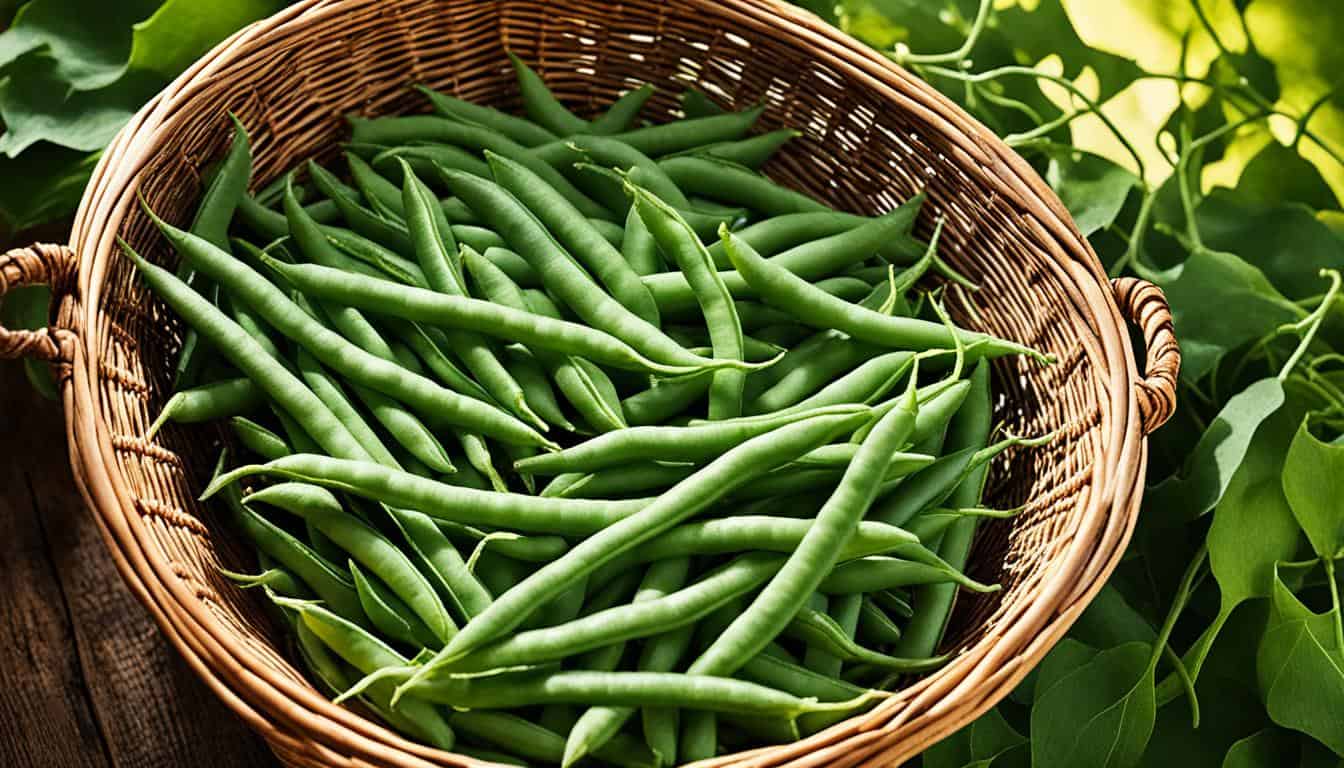
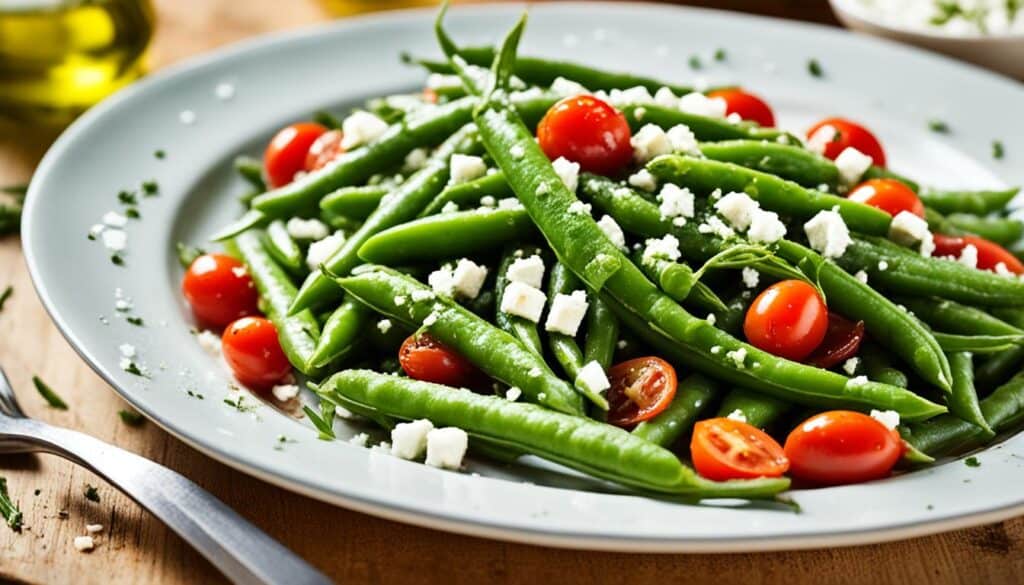
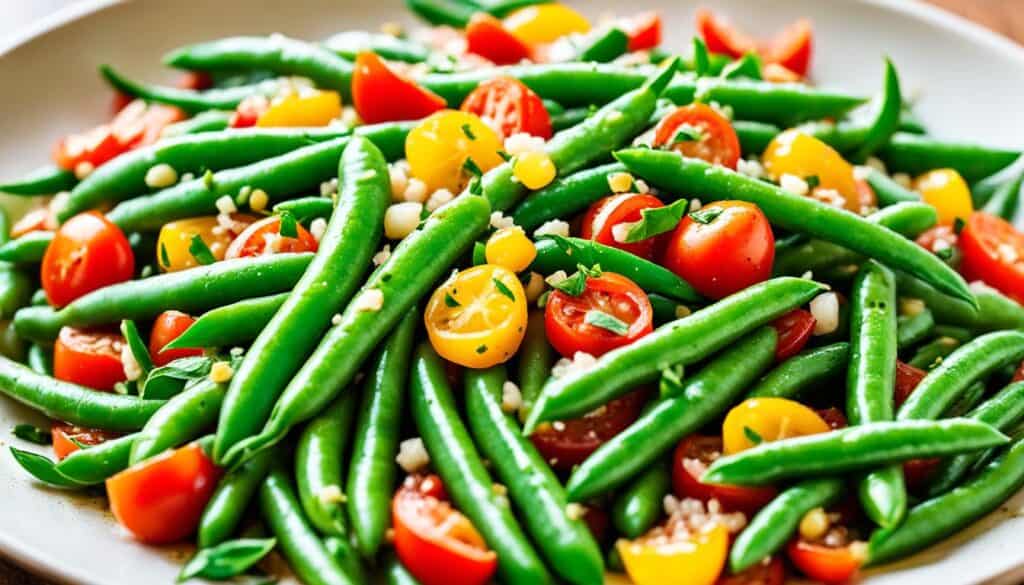
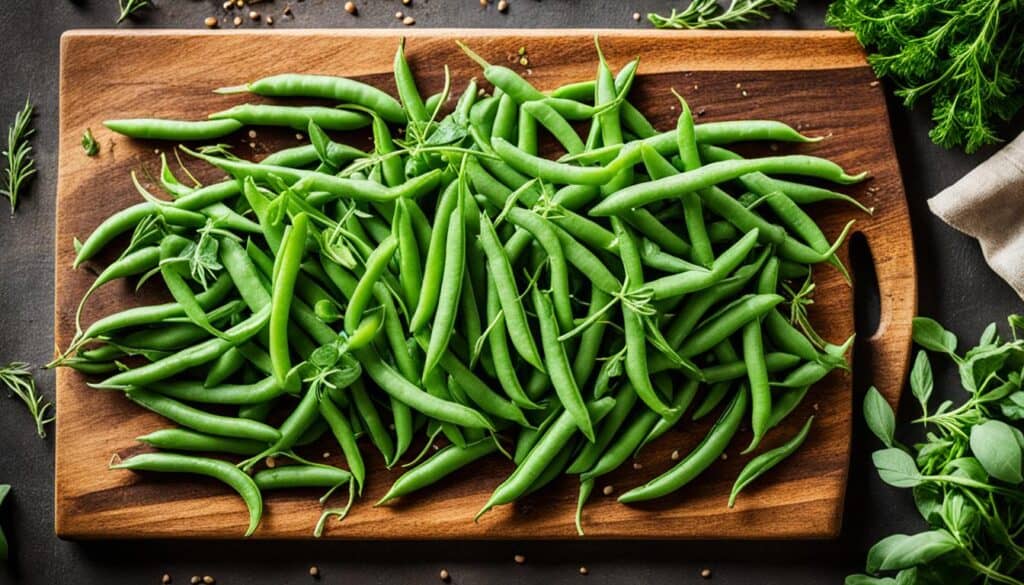
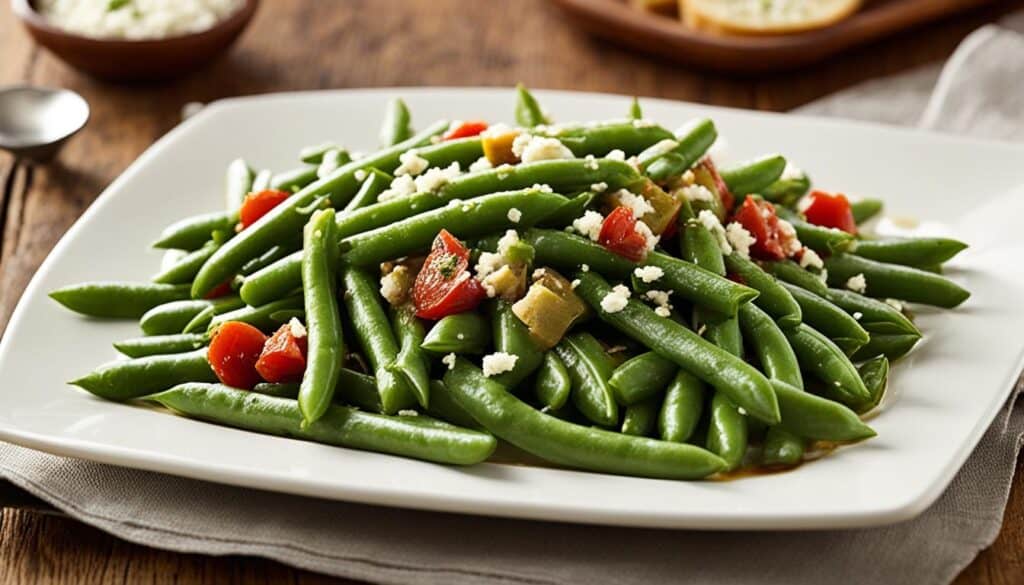
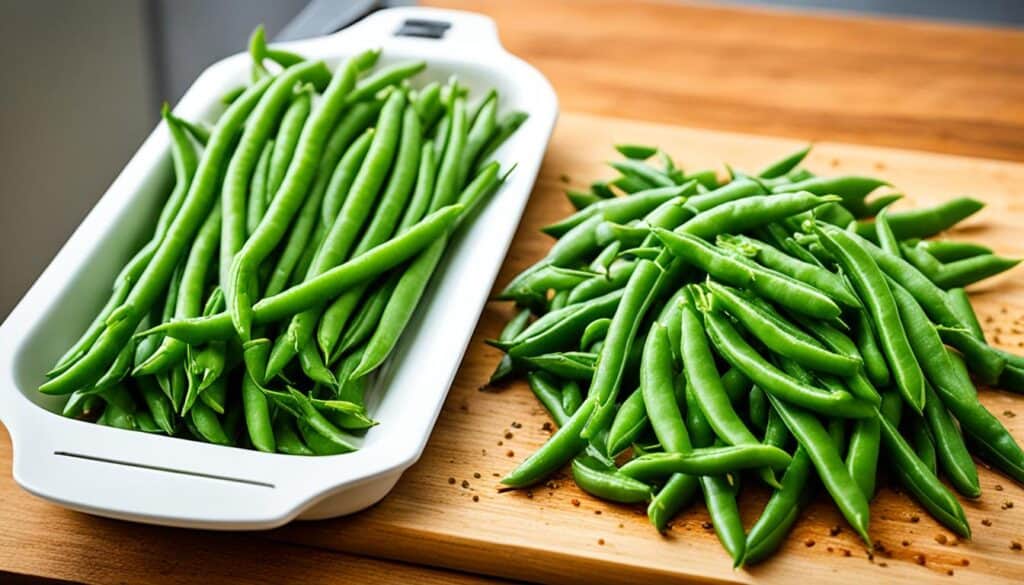



Leave a Reply